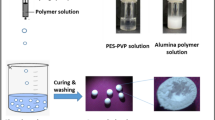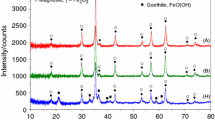Abstract
Magnetite–hydroxyapatite nanocomposites were prepared by in situ precipitation of the calcium phosphate phase in an iron oxide colloidal suspension. Homogeneous magnetic powders were obtained with iron oxide content up to 50 wt%, without perturbation of the magnetite structure nor formation of additional calcium phosphates. The surface area of the composite powder was significantly increased after incorporation of magnetite due to the better apatite particle dispersion. This results in an increased available reactive surface, favoring lead sorption and hydroxypyromorphite precipitation, both leading to an enhanced lead removal capacity of the composite materials. The magnetic properties of magnetite nanocrystals were preserved upon association with hydroxyapatite. Full recovery of the composite powder after lead removal could be achieved using a simple magnet at a relatively low iron oxide content (20 wt%). This indicates a strong interaction between hydroxyapatite and magnetite particles within the composite powder. The procedure is simple, easily scalable and involves only environmental friendly materials.









Similar content being viewed by others
References
Abdel-Ghani NT, Hefny M, El-Chaghaby GAF (2007) Removal of lead from aqueous solution using low cost abundantly available adsorbents. Int J Environ Sci Tech 4(1):67–74
Achelhi K, Masse S, Laurent G, Roux C, Laghzizil A, Saoiabi A, Coradin T (2011) Ultrasound-assisted synthesis of mesoporous zirconia-hydroxyapatite nanocomposites and their dual surface affinity for Cr3+/Cr2O7 2− ions. Langmuir 27(24):15176–15184
Ansar EB, Ajeesh M, Yokogawa Y, Wunderlich W, Varma V (2012) Synthesis and characterization of iron oxide embedded hydroxyapatite bioceramics. J Am Ceram Soc 95(9):2695–2699
Bahdod A, El Asri S, Saoiabi A, Coradin T, Laghzizil A (2009) Adsorption of phenol from an aqueous solution by selected apatite adsorbents: kinetic process and impact of the surface properties. Water Res 43(2):313–318
Baillez S, Nzihou A, Bernache-Assolant D, Champion E, Sharrock P (2007) Removal of aqueous lead ions by hydroxyapatite: equilibria and kinetic processes. J Hazard Mater 139(3):443–446
Benjamin MM, Sletten RS, Bailey RP, Bennett T (1996) Sorption and filtration of metals using iron-oxide-coated sand. Water Res 30(11):2609–2620
Booker NA, Keir D, Priestley A, Rithchie CD, Sudarmana DL, Woods MA (1991) Sewage clarification with magnetite particles. Water Sci Technol 23(7–9):1703–1712
Bouyarmane H, El Asri S, Rami A, Roux C, Mahly MA, Saoiabi A, Coradin T, Laghzizil A (2010) Pyridine and phenol removal using natural and synthetic apatites as low cost sorbents: influence of porosity and surface interactions. J Hazard Mater 181(1–3):736–741
Cao X, Ma LQ, Rhue DR, Appel CS (2004) Mechanisms of lead, copper, and zinc retention by phosphate rock. Environ Pollut 131(3):435–444
Chatterjee J, Haik Y, Chen CJ (2003) Size dependent magnetic properties of iron oxide nanoparticles. J Magn Magn Mater 257(1):113–118
da Silva OG, da Silva Filho EC, da Fonseca MG, Arakaki LNH, Airoldi C (2006) Hydroxyapatite organofunctionalized with silylating agents to heavy cation removal. J Colloid Interface Sci 302(2):485–491
Dong L, Zhu Z, Qiu Y, Zhao J (2010) Removal of lead from aqueous solution by hydroxyapatite/magnetite composite adsorbent. Chem Eng J 165(3):827–834
Dybowska A, Manning DAC, Collins MJ, Wess T, Woodgate S, Valsami-Jones E (2009) An evaluation of the reactivity of synthetic and natural apatites in the presence of aqueous metals. Sci Tot Environ 407(8):2953–2965
El Asri S, Laghzizil A, Coradin T, Saoiabi A, Alaoui A, M’hamedi R (2010) Conversion of natural phosphate rock into mesoporous hydroxyapatite for heavy metals removal from aqueous solution. Colloids Surf A Physicochem Eng Asp 362(1–3):33–38
El Hammari L, Merroun H, Coradin T, Cassaignon S, Laghzizil A (2007) Mesoporous hydroxyapatites prepared in ethanol–water media: structure and surface properties. Mater Chem Phys 104(2–3):448–453
Goya GF, Berquo TS, Fonseca FC, Morales MP (2003) Static and dynamic magnetic properties of spherical magnetite nanoparticles. J Appl Phys 94:3520–3528
Hou CH, Hou SM, Hsueh YS, Lin J, Wu HC, Lin FH (2009) The in vivo performance of biomagnetic hydroxyapatite nanoparticles in cancer hyperthermia therapy. Biomaterials 30(23–24):3956–3960
Jang SH, Min BG, Jeong YG, Lyoo WS, Lee SC (2008) Removal of lead ions in aqueous solution by hydroxyapatite/polyurethane composite foams. J Hazard Mater 152(3):1285–1292
Lower SK, Maurice PA, Traina SJ, Carlson EH (1998) Aqueous Pb sorption by hydroxylapatite: application of atomic force microscopy to dissolution, nucleation, and growth studies. Am Miner 83:147–158
Ma QY, Traina SJ, Logan TJ, Ryan JA (1993) In-situ lead immobilization by apatite. Environ Sci Technol 27:1803–1810
Mir A, Mallik D, Bhattacharya S, Mahata D, Sinha A, Nayar S (2010) Aqueous ferrofluids as templates for magnetic hydroxyapatite nanocomposites. J Mater Sci Mater Med 21(8):2365–2369
Mori K, Kanai S, Hara T, Mizugaki T, Ebitani K, Jitsukawa K, Kaneda K (2007) Development of ruthenium-hydroxyapatite-encapsulated superparamagnetic γ-Fe2O3 nanocrystallites as an efficient oxidation catalyst by molecular oxygen. Chem Mater 19(6):1249–1256
Morup S, Tronc E (1994) Superparamagnetic relaxation of weakly interacting particles. Phys Rev Lett 72(20):3278–3281
Muzquiz-Ramos EM, Cortés-Hernandez DA, Escobedo-Bocardo J (2010) Biomimetic apatite coating on magnetite particles. Mater Lett 64(9):17–19
Nzihou A, Sharrock P (2010) Role of phosphate in the remediation and reuse of heavy metal polluted wastes and sites. Waste Biomass Valor 1(1):163–174
Okoye AI, Ejikeme PM, Onukwuli OD (2010) Lead removal from wastewater using fluted pumpkin seed shell activated carbon: adsorption modelling and kinetics. Int J Environ Sci Tech 7(4):793–800
Oliveira LCA, Rios RVRA, Fabris JD, Garg V, Sapag K, Lago RM (2002) Activated carbon/iron oxide magnetic composites for the adsorption of contaminants in water. Carbon 40(12):2177–2183
Oliveira LCA, Rios RVRA, Fabris JD, Garg V, Sapag K, Lago RM (2003) Clay-iron oxide magnetic composites for the adsorption of contaminants in water. Appl Clay Sci 22(4):169–177
Oliveira LCA, Petkowicz DI, Smaniotto A, Pergher SBC (2004) Magnetic zeolites: a new adsorbent for removal of metallic contaminants from water. Water Res 38(17):3699–3704
Roca AG, Niznansky D, Poltierova-Vejpravova J, Bittova B, Gonzalez-Fernandez MA, Serna CJ, Morales MP (2009) Magnetite nanoparticles with no surface spin canting. J Appl Phys 105(11):114309
Saka C, Sahin O, Kucuk M (2012) Applications of agricultural and forest waste adsorbents fort he removal of lead(II) from contaminated waters. Int J Environ Sci Tech 9(2):379–394
Saoiabi S, El Asri S, Saoiabi A, Laghzizil A, Ackerman JL, Coradin T (2012) Lead and zinc removal from aqueous solutions by aminotriphosphonate-modified converted natural phosphates. Chem Eng J 211–212:233–239
Singh KS, Everett DH, Haul RW, Moscou L, Pierotti RA, Rouquérol J, Siemieniewska T (1985) Reporting physisorption data for gas/solid systems with special reference to the determination of surface area and porosity. Pure Appl Chem 57(11):603–619
Singh RK, El-Fiqi AM, Patel KD, Kim HW (2012) A novel preparation of magnetic hydroxyapatite nanotubes. Mater Lett 75:130–133
Vergés MA, Costo R, Roca AG, Marco JF, Goya GF, Serna CJ, Morales MP (2008) Uniform and water stable magnetite nanoparticles with diameters around the monodomain–multidomain limit. J Phys D Appl Phys 41(13):134003
Wakiya N, Yamasaki M, Adachi T, Inukai A, Sakamoto N, Fu D, Sakurai O, Shinozaki K, Suzuki H (2010) Preparation of hydroxyapatite-ferrite composite particles by ultrasonic spray pyrolysis. Mater Sci Eng, B 173(1–3):195–198
Wang D, Duan X, Zhang J, Yao A, Zhou L, Huang W (2009) Fabrication of superparamagnetic hydroxyapatite with highly ordered three-dimensional pores. J Mater Sci 44(15):4020–4025
Yang Z, Gong X, Zhang C (2010) Recyclable Fe3O4/hydroxyapatite composite nanoparticles for photocatalytic applications. Chem Eng J 165(1):117–121
Yoon S (2011) Determination of the temperature dependence of the magnetic anisotropy constant in magnetite nanoparticles. J Korean Phys Soc 59(5):3069–3073
Acknowledgments
H. Yang and L. Li acknowledge funding support from the National Natural Science Foundation of China (Grant No. 51107139). The authors thank P. Le Griel (LCMCP), P. Beaunier (Laboratoire de Réactivité de Surface, UPMC) and D. Montero (Institut des Matériaux de Paris Centre, UPMC) for electron microscopy imaging.
Author information
Authors and Affiliations
Corresponding author
Electronic supplementary material
Below is the link to the electronic supplementary material.
13762_2014_514_MOESM1_ESM.pdf
Full sets of SEM-FEG and TEM images; magnetic characterization of HAp; enlarged FC–ZFC and hysteresis curves of Fe3O4 and FeH1 powders; kinetics of lead sorption on HAp (PDF 6826 kb)
Rights and permissions
About this article
Cite this article
Yang, H., Masse, S., Rouelle, M. et al. Magnetically recoverable iron oxide–hydroxyapatite nanocomposites for lead removal. Int. J. Environ. Sci. Technol. 12, 1173–1182 (2015). https://doi.org/10.1007/s13762-014-0514-2
Received:
Revised:
Accepted:
Published:
Issue Date:
DOI: https://doi.org/10.1007/s13762-014-0514-2




